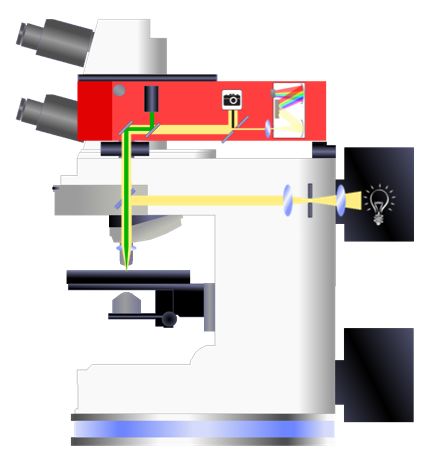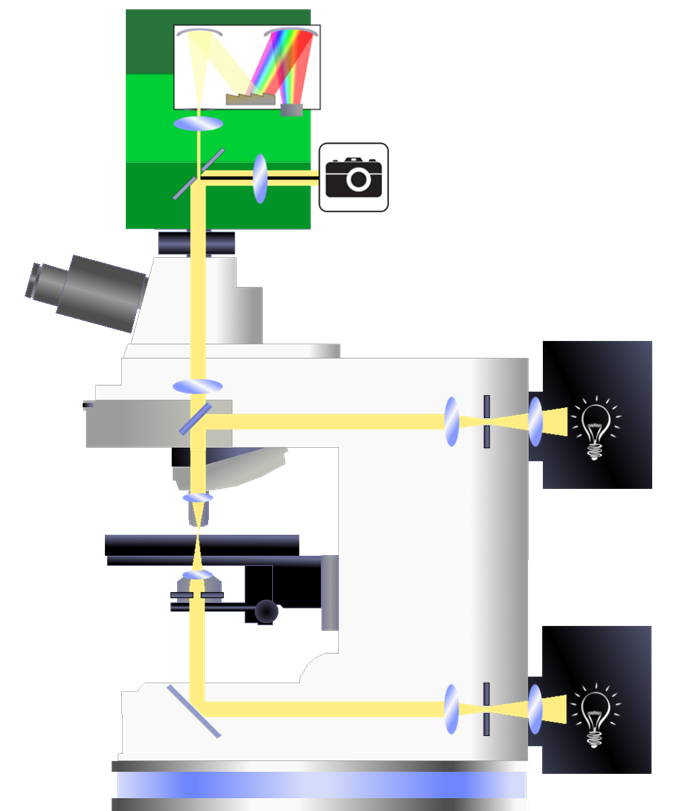Revolutionize Your Microscopy with Raman Spectroscopy!
Optical microscopes are staples in many laboratories, typically used to magnify samples for better observation. However, with the addition of a laser, a Raman spectrometer, and an advanced optical interface from CRAIC Technologies, your microscope can do much more!
CRAIC Technologies micro Raman spectrometers are designed to measure Raman spectra of microscopic samples or small areas of larger objects. While standard Raman spectrometers analyze samples around 1 x 1 centimeters, CRAIC's Raman microspectrometers can measure samples as small as 1 x 1 micrometers, much thinner than a human hair.
The Apollo Raman systems are modular units that integrate seamlessly with upright optical microscopes, adding powerful Raman spectroscopy capabilities. With CRAIC Technologies products, you can quickly and non-destructively acquire high-quality Raman spectra from sub-micron samples.
As depicted in the diagram, the Apollo Raman module integrates with the frame of an upright optical microscope. This module includes lasers, the Raman spectrometer, and integration optics. The laser illuminates the sample, and the Raman spectrometer measures the light collected by the objective and focused onto the spectrometer entrance aperture.
CRAIC micro Raman spectrometers offer even more capabilities. They can be added to other CRAIC microspectrometers and used to measure UV-VIS-NIR microspectra™ in transmission, reflectance, fluorescence, and photoluminescence. Additionally, they are capable of microspot thin film thickness and colorimetry measurements.
Unlock new dimensions in microscopic analysis with CRAIC Technologies' advanced Raman spectroscopy solutions!
Unlock the Full Potential of Your Microscope with CRAIC Raman Spectroscopy!Raman spectroscopy with a microscope!
Optical microscopes are staples in many laboratories, typically used to magnify samples for better observation. However, with the addition of a laser, a Raman spectrometer, and an advanced optical interface from CRAIC Technologies, your microscope can do much more!
CRAIC Raman spectrometers are designed to measure Raman spectra of microscopic samples or small areas of larger objects. While standard Raman spectrometers analyze samples around 1 x 1 centimeters, CRAIC's Raman microspectrometers can measure samples as small as 1 x 1 micrometers, much thinner than a human hair.
The Apollo Raman systems are modular units that integrate seamlessly with upright optical microscopes, adding powerful Raman spectroscopy capabilities. With CRAIC Technologies products, you can quickly and non-destructively acquire high-quality Raman spectra from sub-micron samples.
As depicted in the diagram, the Apollo Raman module integrates with the frame of an upright optical microscope. This module includes lasers, the Raman spectrometer, and integration optics. The laser illuminates the sample, and the Raman spectrometer measures the light collected by the objective and focused onto the spectrometer entrance aperture.
CRAIC Raman microspectrometers offer even more capabilities. They can be configured to measure UV-VIS-NIR microspectra™ in transmission, reflectance, fluorescence, and photoluminescence. Additionally, they are capable of microspot thin film thickness and colorimetry measurements.
Unlock new dimensions in microscopic analysis with CRAIC Technologies' advanced Raman spectroscopy solutions!
Unlock the Full Potential of Your Microscope with CRAIC Raman Spectroscopy!LCD Inspection
LCD Inspection: Color, relative intensity, spectroscopy and film thickness of pixels and light sources.
LCD displays consist of a series of colored lighted areas arranged in a pattern and can only be readily viewed with magnifying optics. They are used as high resolution displays for everything from mobile phones to video displays to MP3 players. There are many different designs but their small scale features cause many quality control challenges.
Due to the nature of LCD displays, they are manufactured with hundreds of rows of microscopic "pixels" on a surface. These pixels can be smaller than 50 microns across. Quality control of both the components and completed LCD displays is done by optical microspectroscopy. Microspectrometers, such as those made by CRAIC Technologies, are used to measure the color and the intensity of the output from individual pixels and from groups of pixels. In fact, CRAIC microspectrometers can be used to map the color and intensity outputs of individual pixels in addition to the entire LCD display including the light source. This is important as manufacturers of LCD displays need to make sure that all the different types of pixels and light sources are the same color and brightness. A microspectrophotometer does this quickly and easily.
To learn more about LCD display testing:
What is a Microspectrophotometer?
Science of Microspectrophotometers
Adding spectroscopy to your microscope!
As shown in the diagram on the right, the MSP head unit can be added to the photoport of a microscope, and the spectrometer measures the light that is collected by the objective and focused onto the spectrophotometer entrance aperture. Whether this light is transmitted through the sample, reflected from the sample, or emitted by the sample, that only changes the calculations done on the light intensity measured.
Beyond just measuring UV-VIS-NIR spectra with microscale sampling areas, microscope spectroscopy is also capable of microspot thin film thickness and colorimetry measurements. When combined with motorized stages, hyperspectral data cubes can even be created with various types of spectra. Because these instruments are so flexible, MSP's are used in many diverse fields of research and industry.
Spectrophotometry with your microscope!
As shown in the diagram on the right, the MSP head unit can be added to the photoport of a microscope, and the spectrometer measures the light that is collected by the objective and focused onto the spectrophotometer entrance aperture. Whether this light is transmitted through the sample, reflected from the sample, or emitted by the sample, that only changes the calculations done on the light intensity measured.
Beyond just measuring UV-VIS-NIR spectra with microscale sampling areas, microscope spectrophotometry is also capable of microspot thin film thickness and colorimetry measurements. When combined with motorized stages, hyperspectral data cubes can even be created with various types of spectra. Because these instruments are so flexible, MSP's are used in many diverse fields of research and industry.





